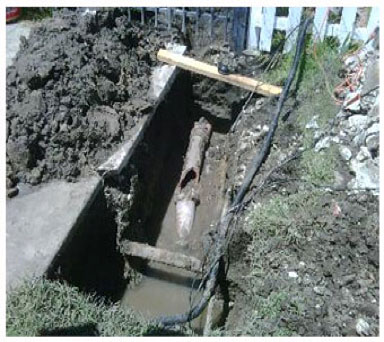
What Is A Sewer Lateral ?
The sewer lateral is a buried pipe (typically 4 inches in diameter) that connects a building’s plumbing system from the foundation to the public sewer main located in the street, an alley, or an easement. Laterals carry sanitary sewage (human waste) and industrial waste. Septic tanks and leach fields (private disposal systems) are not connected to a sewer main. Maintenance of the lateral is generally the responsibility of the property owner. Maintenance of the sewer main is generally the responsibility either of the local jurisdiction (e.g., Public Works Department) or a local sanitary district.
Why Must Sewer Laterals Be Replaced ?
The Environmental Protection Agency (EPA) issues regional discharge permits to treatment plant operators and sewer main owners to assure that storm drains, creeks, rivers, lakes, and estuaries are not polluted by overflows:
- from manholes and clean-outs caused by undersized pipes, tree roots, fats/ oils/ grease, etc., and
- from treatment plants caused by ground water leaking into older mains and laterals (Infiltration & Inflow), which can increase sewer flows by as much as 2000% during inclement (wet) weather .
Older sewer laterals are typically made of clay with cement mortar joints and have cracks and separated joints that are the major source of ground water leaking into sewer mains. The EPA has been vigorously enforcing the Clean Water Act with fines and litigation against jurisdictions and sanitary districts. Consequently, local ordinances have been adopted requiring property owners to test and replace their aging sewer laterals and to eliminate flushing fats/oils/grease, pharmaceuticals, and hazardous materials down toilets, sinks, and floor drains.
What Permits Are Needed To Repair Or Replace A Sewer Lateral ?
Both the California Plumbing Code and local sanitary sewer ordinances regulate sewer laterals. Different jurisdictions control laterals differently. Some assign the Upper Lateral between the foundation and the property line (“back of sidewalk”) to the Plumbing Code and the Lower Lateral from the property line to the sewer main to a local sewer ordinance. Others assign the entire lateral to a local ordinance. Some jurisdictions also require additional permits for cutting the sidewalk, digging in the street, and tapping into the main.
What Are Backwater Valves ?
The Plumbing Code requires protection for the building and occupants from sewer main backups overflowing through toilets, showers, and bathtubs which are below the upstream manhole cover. A Backwater Valve is a one-way “flapper” installed in the building’s sewer pipe which closes when sewage backs-up from the main. To install a Backwater Valve correctly, the building’s plumbing must be split to isolate the “low-level” fixtures from the rest of house plumbing. As a temporary alternative, some jurisdictions allow the installation of an overflow valve onto the building’s sewer lateral clean-out, which allows backed-up sewage to flow into the yard.
Check the Links below and your jurisdiction’s website for additional information.
Links
BUILDING in CALIFORNIA
- Illustrations
- Forms – Jurisdictions
- Media – Back Water Valve Video
California Association of Sanitation Agencies
US Environmental Protection Agency
Other Links: